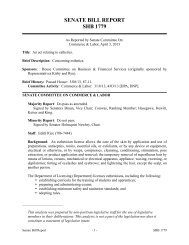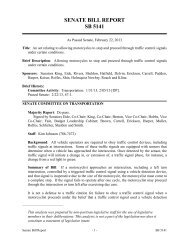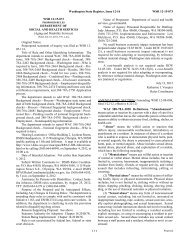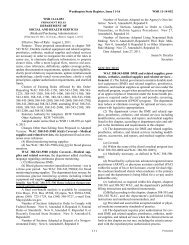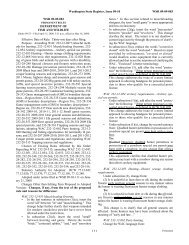Proposed
Proposed
Proposed
Create successful ePaper yourself
Turn your PDF publications into a flip-book with our unique Google optimized e-Paper software.
answers to the questions now may avoid unnecessary delays<br />
later.<br />
Some questions ask about governmental regulations,<br />
such as zoning, shoreline, and landmark designations.<br />
Answer these questions if you can. If you have problems, the<br />
governmental agencies can assist you.<br />
The checklist questions apply to all parts of your proposal,<br />
even if you plan to do them over a period of time or on<br />
different parcels of land. Attach any additional information<br />
that will help describe your proposal or its environmental<br />
effects. The agency to which you submit this checklist may<br />
ask you to explain your answers or provide additional information<br />
reasonably related to determining if there may be significant<br />
adverse impact.<br />
Use of checklist for nonproject proposals:<br />
Complete this checklist for nonproject proposals, ((even<br />
though questions may be answered "does not apply." IN<br />
ADDITION, complete the SUPPLEMENTAL SHEET FOR NONPRO-<br />
JECT ACTIONS (part D))) including the supplemental sheet for<br />
nonproject actions (Part D). When the questions for the environmental<br />
elements (Part B) do not contribute meaningfully<br />
to the analysis of the proposal, they may be excluded by the<br />
lead agency.<br />
For nonproject actions, the references in the checklist to<br />
the words "project," "applicant," and "property or site"<br />
should be read as "proposal," "proposer," and "affected geographic<br />
area," respectively.<br />
A. BACKGROUND<br />
1. Name of proposed project, if applicable:<br />
2. Name of applicant:<br />
3. Address and phone number of applicant and contact person:<br />
4. Date checklist prepared:<br />
5. Agency requesting checklist:<br />
6. <strong>Proposed</strong> timing or schedule (including phasing, if applicable):<br />
7. Do you have any plans for future additions, expansion, or<br />
further activity related to or connected with this proposal? If<br />
yes, explain.<br />
8. List any environmental information you know about that<br />
has been prepared, or will be prepared, directly related to this<br />
proposal.<br />
9. Do you know whether applications are pending for governmental<br />
approvals of other proposals directly affecting the<br />
property covered by your proposal? If yes, explain.<br />
10. List any government approvals or permits that will be<br />
needed for your proposal, if known.<br />
11. Give brief, complete description of your proposal, including<br />
the proposed uses and the size of the project and site.<br />
There are several questions later in this checklist that ask you<br />
to describe certain aspects of your proposal. You do not need<br />
to repeat those answers on this page. (Lead agencies may<br />
Washington State Register, Issue 12-21 WSR 12-21-125<br />
modify this form to include additional specific information<br />
on project description.)<br />
12. Location of the proposal. Give sufficient information for<br />
a person to understand the precise location of your proposed<br />
project, including a street address, if any, and section, township,<br />
and range, if known. If a proposal would occur over a<br />
range of area, provide the range or boundaries of the site(s).<br />
Provide a legal description, site plan, vicinity map, and topographic<br />
map, if reasonably available. While you should submit<br />
any plans required by the agency, you are not required to<br />
duplicate maps or detailed plans submitted with any permit<br />
applications related to this checklist.<br />
TO BE COMPLETED BY APPLICANT<br />
B. ENVIRONMENTAL ELEMENTS<br />
EVALUATION FOR<br />
AGENCY USE<br />
ONLY<br />
1. Earth<br />
a. General description of the site (circle one): Flat, rolling,<br />
hilly, steep slopes, mountainous, other . . . . . .<br />
b. What is the steepest slope on the site (approximate percent<br />
slope)?<br />
c. What general types of soils are found on the site (for<br />
example, clay, sand, gravel, peat, muck)? If you know<br />
the classification of agricultural soils, specify them and<br />
note any prime farmland.<br />
d. Are there surface indications or history of unstable soils<br />
in the immediate vicinity? If so, describe.<br />
e. Describe the purpose, type, and approximate quantities<br />
of any filling or grading proposed. Indicate source of<br />
fill.<br />
f. Could erosion occur as a result of clearing, construction,<br />
or use? If so, generally describe.<br />
g. About what percent of the site will be covered with<br />
impervious surfaces after project construction (for example,<br />
asphalt or buildings)?<br />
h. <strong>Proposed</strong> measures to reduce or control erosion, or other<br />
impacts to the earth, if any:<br />
2. Air<br />
a. What types of emissions to the air would result from the<br />
proposal (i.e., dust, automobile, odors, industrial wood<br />
smoke) during construction and when the project is completed?<br />
If any, generally describe and give approximate<br />
quantities if known.<br />
[ 175 ] <strong>Proposed</strong>



